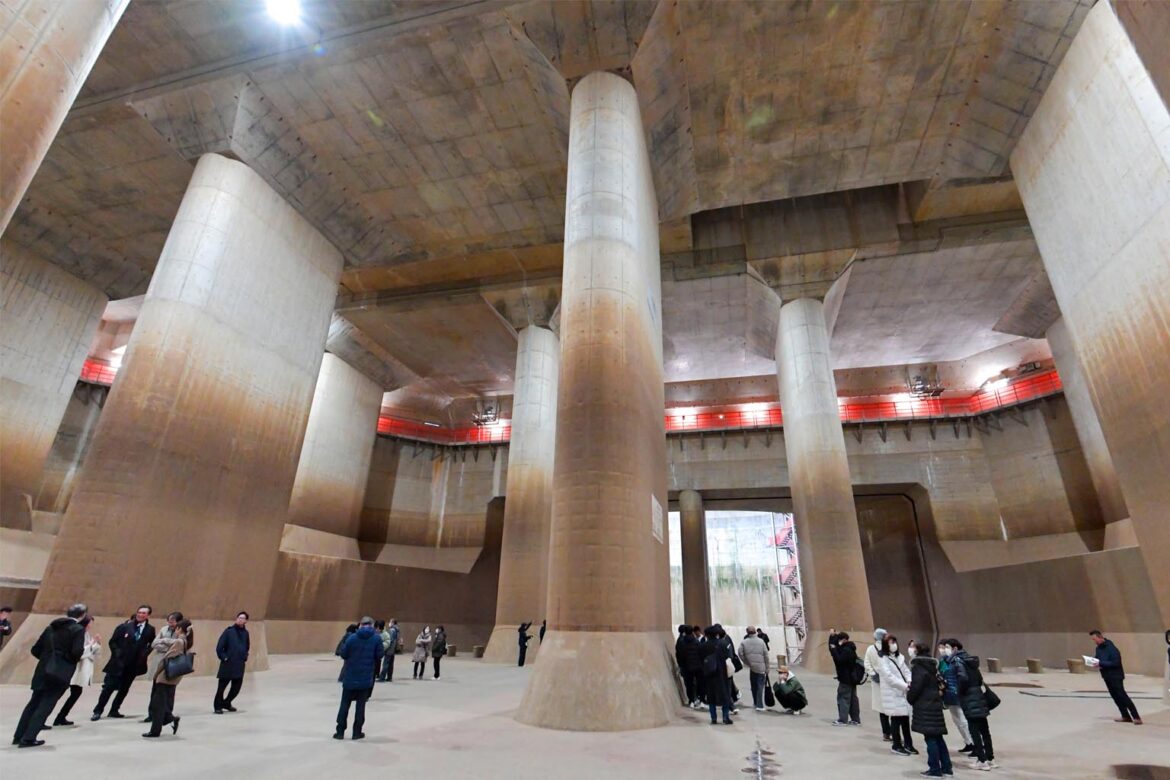Beneath a quiet suburb north of Tokyo lies a massive concrete structure few suspect exists. With its towering pillars and eerie silence, it feels more like a lost temple than a flood control system. Yet this hidden giant plays a critical role in protecting millions from nature’s fury.
The colossal underground flood canal
Officially named the Metropolitan Area Outer Underground Discharge Channel, this engineering marvel shields Tokyo and surrounding towns from devastating floods triggered by typhoons and heavy rainfall. Located 30 miles north of the city in Saitama Prefecture, it plunges roughly 165 feet below the surface, making it the largest underground floodwater system in the world.
The scale is staggering. Visitors often compare it to the mythical Mines of Moria from The Lord of the Rings, yet every inch is real—built from steel, concrete, and necessity. Its six-kilometer underground stretch can store up to 670,000 cubic meters of floodwater—equivalent to 268 Olympic swimming pools—offering crucial protection to Tokyo, a city that sees over 63 inches of rainfall annually.
A high-tech response to rising waters
Construction began in 1993 and took 13 years, costing more than a billion dollars. The canal acts as a massive pressure valve, redirecting overflow from nearby rivers during intense storms to the Edo River, keeping densely populated neighborhoods safe. It is typically activated seven times a year, primarily during typhoons and torrential rains, preventing potentially catastrophic damage.
Urbanization has replaced much of Tokyo’s natural absorbent soil with asphalt and concrete, making flood management even more critical. “This system shows how engineering can protect cities against climate extremes,” says Nobuyuki Tsuchiya, Deputy Director at the Japanese River Research Center. “Managing water isn’t just about reacting. Cities must anticipate challenges for the next 100 years.”
A cathedral beneath the city
Stepping inside, visitors are met with a breathtaking sight : 59 massive concrete pillars, each 59 feet tall, arranged in perfect rows to support the enormous water chamber. Each pillar could theoretically house the Statue of Liberty. The central hall, dimly lit and impossibly vast, has earned the nickname “underground sanctuary”.
Tourists descending narrow staircases report instant awe. “When I reached the bottom and saw the scale, I was stunned,” one visitor told the South China Morning Post. The space evokes the grandeur of the Roman Pantheon or Istanbul’s Basilica Cistern, but unlike those ancient sites, it’s fully modern and still operational.
Despite its cathedral-like appearance, this structure is not meant to impress—it is functional. Its silent vigilance reminds us that nature’s power can be managed, but never ignored.
Engineering meets Instagram
Originally off-limits to the public, the canal now offers guided tours under strict scheduling rules. Visitors often wear construction boots to navigate the slippery concrete floors. Its surreal lighting, massive pillars, and raw industrial beauty have made it a hotspot for photographers and social media influencers seeking a unique backdrop.
Yet for all its viral appeal, the canal’s main purpose remains protection. According to Japan’s Ministry of Land, Infrastructure, Transport and Tourism, the facility has prevented over a billion dollars in potential flood damage since it became operational. However, its coverage is limited—only three Tokyo wards and several northern towns benefit directly from its protection.
This enormous underground project is part of a broader national strategy, including strengthened levees, surface reservoirs, riverbank redevelopment, and climate-conscious urban planning. It stands as a testament to forward-thinking infrastructure: a silent guardian working day and night beneath one of the world’s largest cities.
Visiting the site, it’s impossible not to reflect on the balance between human ingenuity and nature’s unpredictability. On a personal note, I remember touring the chamber and feeling a mix of humility and amazement—humility at the scale of what nature can do, and amazement at what humans can achieve when necessity drives creativity. It’s a lesson in planning ahead, in seeing challenges as opportunities for bold solutions, and in respecting the environment even as we shape it.
Whether you’re an engineering enthusiast, a history lover, or just curious about hidden urban marvels, Tokyo’s underground flood canal offers a glimpse of how human innovation meets natural threats. Silent, massive, and meticulously designed, it is a modern sentinel, proof that even the most ordinary suburbs can hide extraordinary wonders.
If you’ve ever explored unique infrastructure or unusual urban spaces, share your experience. How do you think cities should prepare for the increasing threats of climate change and extreme weather ? Leave your thoughts, comments, and photos—we’d love to see them.


AloJapan.com